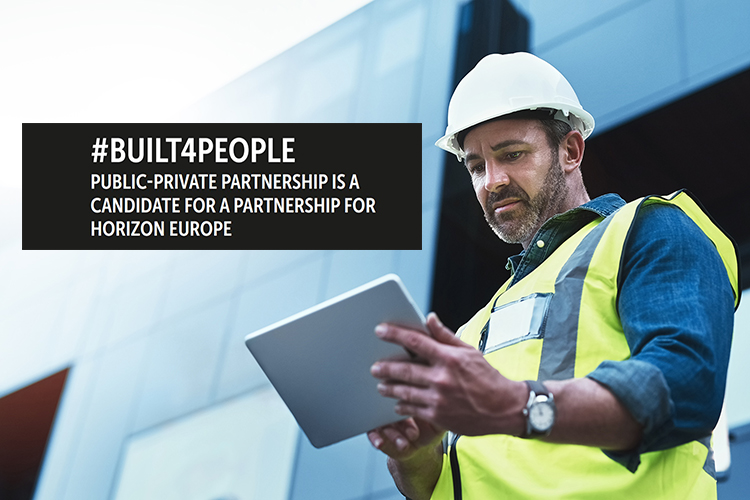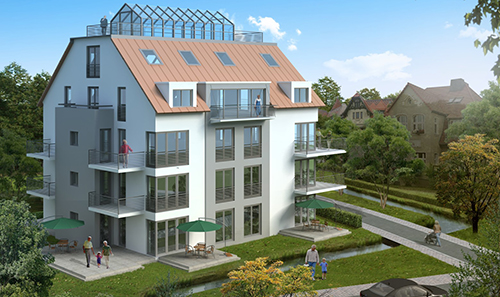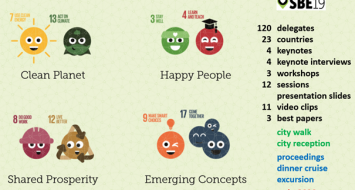
Achieving the twin-transition in the built environment - Build4People partnership
Authors:
Isabel Pinto Seppä, Dr.Sc.Tech
EU Affairs Manager at VTT,
Coordinator of the ECTP Digital Built environment committee
Alain Zarli
ECTP – Secretary General, R2M – Managing Partner
Extremely resource and energy intensive, embedded in our lives, and with heavy socio-economic impacts, the built environment sector has the potential, like any other, to support the European Green deal policies contributing to Europe target of climate neutrality by 2050. There is an urgency for a transformation for sustainable living, enhanced by the transition to a digitalized sector. Achieving this twin-transition is critical as well is the integration of the sector with other key value chains. This demands the commitment of all society from public to industry, policy makers and citizens.
Within the planning of the new R&D&I EU Framework program (2021-20207), the European Commission services, with stakeholders along the whole construction value chain, has started the devlopment of the Built4People Public-Private Partnership (B4P). The primary role of the partnership is to define, and implement, the R&D&I activities that need to be performed to achieve the sector transformation. Here we highlight these planned activities, for the next 7 years, focusing on offering pathways for the sector decarbonization towards a built environment as a CO2 sink for the future.
Decarbonisation of the EU building stock, energy and mobility
Activities are planned targeting the decarbonisation of the EU building stock, in line with the EPBD15 directive, and the contribution to the decarbonisation of other sectors like the energy and transport ones. These R&D activities will support the implementation of the European green deal renovation wave and will focus on:
- Demonstrating reduced energy consumption, increased flexibility to accommodate more renewables and give the benefit to citizens by paying less, reducing energy poverty.
- Developing solutions to turn buildings, and districts, as producers of energy.
- Solutions for supply and integrate the needed supporting network infrastructure for the energy transition, both for stationary and transport sectors.
Achieving a circular construction sector
Research and innovation actions will target impacts for the optimization of the use of resources and results in zero waste to landfill, which facilitates the use of secondary materials from construction and demolition waste and promotes design for reuse practices, decreasing carbon footprint and increasing carbon handprint. New business opportunities with reduced risk for investors, opening the supply chain to reused/repaired products, reuse/refurbish buildings, demolitions and urban mining, should be researched and validated. Pilots for the Integration of construction and demolition waste in new constructions and industrial and regional symbiosis will be supported.

Construction and renovationof buildings, and infrastructure, must be carried out in a way that does no harm, but rather actually enhances our natural environment.
A shift to mainstreaming life cycle costing approaches
The goal is the development of an investor-friendly framework, integrating sustainability principles to property valuations and risks ratings with enough flexibility to be updated regularly. Research and innovation should outcome solutions bringing value for building owners, and increased flow of capital investment and long-term finance into the built environment as a sustainability asset. This includes models and digital tools for better-informed decision making on investments and improved risk management for the built environment. The Partnership also proposes finance support for pilots on a standardization framework and progressive regulation.
Improve resilience of buildings and infrastructure
The goal is to Increase the resilience of the built environment to protect and enhance social, environmental and economic value in the future. The built environment should be future-proof and withstand dramatic changes in climate and other threats like seismic activity, terrorism or cybercrimes as well as adapt to social and demographic changes. This will include actions for designs, materials and solutions to improve resilience, preparedness & responsiveness of the built environment to disruptive events; Predictive and integrated maintenance solutions and processes; Big data-based building and infrastructure real-time management, monitoring and maintenance and ; Interactive operation and management of city assets.
Boost green and blue infrastructure, and provide ecosystem services
Construction and renovation of buildings, and infrastructure, must be carried out in a way that does no harm, but rather actually enhances our natural environment. This demands a better integration of buildings to the city networks, in particular heat grids, and water. Solutions are needed for the optimized management of wastewater and rainwater encouraging the local re-use of water. In addition holistic approaches for the integration of circular economy and nature-based solutions (NBS), at the scale of building blocks and districts, will be supported targeting, for example, reduce the heat island and improve heat control, green corridors to reintroduce more biodiversity in cities and solutions for the integration of food production within the built environment.
Social inclusion, cultural value and just transition:
This transition must benefits all of Europe’s citizens, preserve its cultural heritage and architecture, protects the most vulnerable groups and, at the same time mitigate negative impacts by creating new job and business opportunities. This demands solutions for affordable and feature-adapted built environment for users and inhabitants including low-disruptive construction and retrofitting processes as well as health and wellbeing. Finance support is recommended for pilots on solutions for the ageing population, and on certification of built environment with regard to expected or agreed user-centric functions and characteristics. Demonstration of low carbon, resource efficient, open, accessible and inclusive solutions for conservation and embellishment of cultural heritage built environment assets will be supported.
To achieve citizens health and wellbeing the entire built environment should be designed to promote healthy lifestyles for all citizens in non-toxic environment. Research priorities will focus on demonstrating enhanced health and wellbeing through improved indoor and outdoor environment.
The European Single Entry Point for innovation transfer to the Built Environment
The Build4People partnership provides a bridge between R&D&I and the market and Most of the activities will be undertaken in project consortia formed in response to the calls launched under the Partnership umbrella. However, the activities are to be considered in global, national and regional stakeholders ecosystems. The aim is to create a number of interconnected, comprehensive value chain innovation clusters in Member States and regions in order to achieve a scale and (long-term) duration that will not be achieved via individual projects. Build4People will act as a Single Entry Point, in Europe, for innovation transfer to the Built Environment.

Isabel Pinto Seppä
Dr.Sc.Tech. EU Affairs Manager at VTT, coordinator of the ECTP Digital Built environment committee

Alain Zarli
ECTP – Secretary General, R2M – Managing Partner
Suosituimmat

SBE19 approached sustainable built environment from three di...
SBE19 Helsinki was organized by the Finnish Association of Civil Engineers RIL and Sustain...

Bygg X: the next disruption for the building industry
The building industry is facing substantial technical challenges related to the diversity,...


